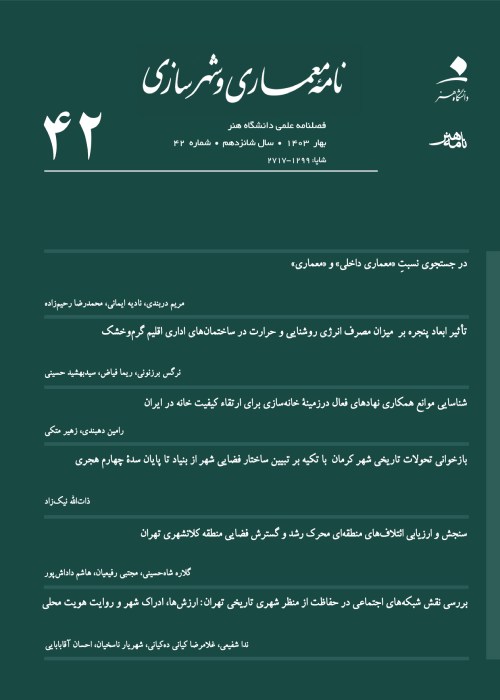Dynamics of Magnitude of Physical Changes with an Emphasis on Resident’s Narratives; Guideline for Designers in Residential Neighborhoods Case Study: Niavaran Neighborhood, Tehran
Author(s):
Article Type:
Research/Original Article (دارای رتبه معتبر)
Abstract:
Management of physical dimensions in residential neighborhood requires special attention to residents and their perceptions due to the impacts on quality of life. Some research has been done in this regard, with emphasis on cognitive, social and psychological aspects, and mostly focused on human-environment relationship. On the other hand, preparing positive theories and design guidelines for designers to provide optimal physical transformation requires consideration of both morphological processes as well as paying attention to residents’ point of view. Understanding residents’ narratives of magnitude of physical changes requires qualitative methods of analysis to verify compliance with objective facts. The main objective of this study was to understand the residents’ perception of magnitude of physical changes in order for establishing design guidelines for physical development management in residential neighborhoods. This exploratory study used mix-method research. Among the original methods of qualitative research, phenomenography was employed because of its focus on categorizing residents’ different perception of magnitude of physical changes during the past 20 years. To increase the validity of the findings, qualitative, intermediate and final stages of a complete cycle of evolution were selected. Totally, 14 old residents in two groups and four alleys were chosen for survey. Concepts and issues identified by them were classified using a coding. Morphological and quantitative studies also was performed. Then, based on adaptive research approaches, guidelines for designers, ranging from urban designers, landscape architects and architects were established for this purpose. The results reveals that morphological studies of how physical dimensions change including height, density, mass and space, and envelope change over time are intertwined with semantic and symbolic and biodiversity issues such as relevance to open spaces. During the course of physical changes, two issues are more important; first, changing the nature of the elements that had a particular identity in the past and the second, new things that have never been seen before. In terms of physical transformation, the most important principle is the size and elements of view and their dimensions. Land-related issues such as yard and the size of houses play a more important role, and socio-spatial identity becomes highly dependent on the body. The results also provide approaches to policymaking based on differences in resident quality assessment mechanisms and to improve lives at varying intensities. The criteria as a guide for designer can be summarized as follows. Greater physical and altitudinal coordination between buildings and shorter construction time cycles as a pleasant stimulus have become a prominent aspect of resident's time of adaptation. The presence of side walls overlooking the alley is an important factor in reinforcing the mentality suspension. Prolonging the construction period and transformation of the alley into a semi-complete construction workspace will become an effective factor in satisfaction of residents. Finally, it seems that preparation of a documentation for each alley, controlling the magnitude of physical changes in terms of number and type in neighborhoods like Niavaran is necessary. Because, in each period a type and a scale of physical traits as a local identity is established in the minds of residents, which requires maintenance and mentoring during gradual changes.
Keywords:
Language:
Persian
Published:
Journal of Architecture and Urban Planning, Volume:13 Issue: 28, 2020
Pages:
29 to 49
https://magiran.com/p2238711
دانلود و مطالعه متن این مقاله با یکی از روشهای زیر امکان پذیر است:
اشتراک شخصی
با عضویت و پرداخت آنلاین حق اشتراک یکساله به مبلغ 1,390,000ريال میتوانید 70 عنوان مطلب دانلود کنید!
اشتراک سازمانی
به کتابخانه دانشگاه یا محل کار خود پیشنهاد کنید تا اشتراک سازمانی این پایگاه را برای دسترسی نامحدود همه کاربران به متن مطالب تهیه نمایند!
توجه!
- حق عضویت دریافتی صرف حمایت از نشریات عضو و نگهداری، تکمیل و توسعه مگیران میشود.
- پرداخت حق اشتراک و دانلود مقالات اجازه بازنشر آن در سایر رسانههای چاپی و دیجیتال را به کاربر نمیدهد.
In order to view content subscription is required
Personal subscription
Subscribe magiran.com for 70 € euros via PayPal and download 70 articles during a year.
Organization subscription
Please contact us to subscribe your university or library for unlimited access!


